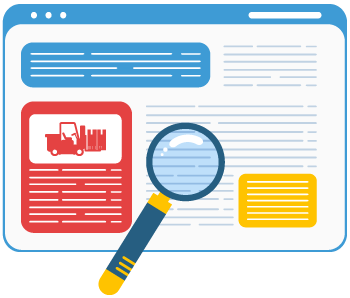The Role of Software in Business Improvement Strategies
Built For





Business improvement strategies and the role of software in supporting these strategies

In today’s rapidly evolving and fiercely-completive business landscape, businesses are continually seeking ways to enhance efficiency, improve operations, and stay ahead of the competition. The most powerful tool that has emerged as a game-changer in driving business improvement strategies is technology. Software solutions have revolutionized businesses’ operations, enabling streamlined processes, data-driven decision-making, and enhanced collaboration. From inventory and order management to visibility and analytics, software is pivotal in supporting and amplifying business improvement efforts. In this article, we explore how software empowers organizations to achieve business improvement objectives, providing a competitive advantage in an ever increasingly digital world.
Understanding business improvement strategies
What are business improvement strategies?

Business improvement strategies refer to the deliberate and systematic actions businesses take to enhance operations, achieve goals, and stay competitive. These strategies focus on identifying and implementing improvements across various organizational areas to drive growth, efficiency, and profitability.
The importance of business improvement in today’s competitive landscape
Business improvement strategies are critical in driving success and growth, enabling organizations to stay ahead by continuously adapting, innovating, and optimizing their operations. By embracing business improvement strategies, companies enhance operational efficiency, reduce costs, and deliver superior products or services. Moreover, it allows businesses to meet and exceed evolving customer expectations, increasing customer satisfaction and loyalty. In an era of market disruptions and rapid technological advancements, companies prioritizing improvement are better equipped to navigate challenges, seize new opportunities, and maintain a competitive edge in the ever-changing business landscape.
Common challenges businesses face that can be addressed through improvement strategies
Businesses face numerous challenges in today’s dynamic and competitive environment. However, implementing strategic business improvement approaches can effectively address these challenges. Some common challenges companies face include:
Operational inefficiencies
Inefficient processes, redundant tasks, and bottlenecks can hinder productivity and increase costs. Effective business improvement strategies such as process optimization, automation, and workflow redesign can address these challenges, improving operational efficiency.
Customer satisfaction and retention
Customer satisfaction and retention are pivotal for businesses, as meeting customer expectations and maintaining high satisfaction create long-term success. Implementing optimized processes at every potential customer satisfaction (or dissatisfaction) point in an organization –from purchasing to order fulfillment to customer service – will be rewarded with loyalty and positive feedback for prioritizing customer needs and desires.
Technological advancements
Rapid technological advancements can present both opportunities and challenges and are addressed in most business improvement strategies. Businesses that stay abreast of technological developments and solutions and leverage them to their advantage have, and will continue to have, a competitive advantage. Strategies such as digital transformation, adopting emerging technologies, and investing in innovation keep businesses relevant and competitive.
Financial management
Businesses must employ robust cost-control measures and efficient resource allocation to maintain the financial stability crucial for business success. These strategies are essential in addressing challenges head-on and ensuring the long-term sustainability and profitability of the business in a dynamic market landscape.
Changing market demand
Shifting customer preferences, market trends, and disruptive innovations can pose challenges. Businesses need to stay agile and adapt quickly. Strategies like demand planning, product diversification, and agile inventory management help companies to navigate these challenges effectively.
Regulatory compliance
Many businesses face various regulations and compliance requirements in their operations. Developing compliance strategies, implementing monitoring systems, and staying informed about relevant laws ensure legal adherence and mitigate compliance risks.
By recognizing and proactively addressing these common challenges through effective business strategies, organizations enhance their competitiveness, mitigate risks, and seize opportunities for growth and success.
The evolution of software in business improvement
How software has transformed traditional business processes
Software has revolutionized traditional business processes by streamlining operations, increasing efficiency, and enhancing productivity. Many tasks were performed manually in the past, leading to potential errors, delays, and higher costs. However, with the advent of software applications, businesses automate repetitive tasks such as entering data, managing inventory, and generating reports. This automation reduces human error and frees up valuable time for employees to focus on more strategic and creative aspects of their work. Furthermore, software enables real-time monitoring and reporting, providing businesses with accurate and up-to-date insights into their operations, allowing for better decision-making, improved resource allocation, and quick responses to changing market conditions.
From keypunch cards to basic spreadsheets to advanced business intelligence

The evolution of software tools has brought about transformative changes in business processes over the years. From the early days of keypunch cards, which required manual input and batch processing, to the introduction of basic spreadsheets, businesses gained more control and flexibility in managing data and calculations. As technology advanced over the decades, the development of business intelligence and automation solutions revolutionized decision-making and operational efficiency, key elements of business improvement strategies.
1960s: Mainframe computers, keypunch cards, and magnetic tape drives.
In the 1960s, technology was mostly limited to large organizations compared to today’s advanced technologies for businesses of all sizes. However, early software tools laid the foundation for the digital transformation that would follow in the subsequent decades.
1970s: Minicomputers, local area networks (LANs), and word processing systems.
These technologies were crucial in enhancing productivity, improving communication, and enabling more efficient data processing and document management for average businesses during the 1970s.
1980s: Personal computers (PCs), fax machines, electronic mail (email), and point of sale (POS) systems.
The 1980s brought about significant advancements in business operations, empowering individuals with PCs and transforming how information was shared and processed with the widespread adoption of email, spreadsheets, database management systems, project management tools, and desktop publishing. Additionally, QuickBooks was created by Intuit in 1983.
1990s: Internet and the world wide web, enterprise resource planning (ERP) systems, mobile phones, and cellular networks.
The technologies of the 1990s brought about significant changes in how businesses operated, communicated, and managed their resources, laying the foundation for a more interconnected and digitally-driven business landscape that would continue to evolve in the following decades.
2000s: Internet-based applications and eCommerce, customer relationship management (CRM) systems, and cloud computing.
Technology of the 2000s transformed the way businesses interacted with customers, managed their operations, and utilized IT resources.
2010s: Mobile computing and smart devices, data analytics, and cloud-based solutions.
The 2010s shaped the digital transformation of businesses, facilitating increased mobility, empowering data-driven decision-making, and providing scalable and cost-effective software solutions, enabling companies to adapt and thrive in an increasingly connected and data-centric world.
2020s and beyond…
The evolution of software in the realm of business improvement has been remarkable, with advancements in technology offering a wide array of sophisticated tools and applications. Businesses have gained, and will continue to gain, a competitive advantage by embracing technology-based strategies that drive innovation, enhance customer experiences, and improve overall performance. Software has emerged as a transformative force, empowering organizations to adapt, evolve, and thrive in today’s dynamic business environment.
The advantages of using advanced technology and software in business improvement strategies

While spreadsheets and word processing software are still highly useful in our daily lives, businesses today greatly benefit from advanced technologies and software solutions that offer more comprehensive capabilities. Modern software tools encompass a wide range of functionalities, including collaboration, automation, and data analytics, enabling businesses to streamline operations, improve decision-making, enhance customer experiences, and drive innovation. By embracing advanced software solutions, companies unlock greater efficiency, scalability, and competitive advantages in an increasingly digital-driven world.
Advanced technologies and software provide the tools to conquer numerous business challenges, including:
Inventory and warehouse management
Maintaining optimal inventory levels, improving productivity and warehouse efficiency, accurately tracking stock, and reducing stock obsolescence helps businesses streamline processes, reduce costs, and improve overall supply chain efficiency.
Manual and repetitive tasks
Software automates manual and repetitive tasks, reducing human error and allowing employees to focus on more strategic and value-added activities.
Data management and analysis
Businesses often struggle with managing and analyzing large volumes of data. Software solutions, such as data analytics and business intelligence tools, help companies organize, analyze, and derive valuable insights from their data.
Communication and collaboration
Inefficient communication and lack of collaboration hinder productivity and create bottlenecks. Software facilitates communication, file sharing, and collaboration among team members.
Customer relationship management (CRM)
Managing customer relationships effectively is crucial for businesses. CRM software enables companies to centralize customer information, track interactions, manage sales pipelines, and improve customer service, resulting in better customer relationship management and enhanced customer satisfaction.
Compliance and regulatory requirements
Software solutions have become invaluable in regulatory compliance and adherence to industry standards, assisting in effectively tracking and managing compliance requirements, generating accurate reports, and ensuring businesses comply with the necessary regulations.
Scalability and growth
As businesses grow, operations become more complex, necessitating a focus on managing growth and scalability, critical components of business improvement strategies. Scalability refers to an organization’s ability to handle increased demands and expand its operations efficiently. Implementing software solutions tailored for scalability enables businesses to adapt to changing market conditions, handle growing customer bases, and accommodate increased transaction volumes without sacrificing performance or quality. By leveraging advanced software tools, businesses optimize processes, automate workflows, and improve resource allocation to ensure smooth operations at any scale.
Achieving competitive advantages through business improvement strategies based on technology

Operational efficiency
Implementing software as a part of business improvement strategies enables businesses to achieve operational efficiency by streamlining processes, automating tasks, and improving data management. With software solutions, businesses:
- Eliminate manual and time-consuming tasks, reducing errors and improving efficiency.
- Consolidate and analyze information, providing valuable insights for process optimization and decision-making.
- Monitor key performance indicators and make informed decisions promptly.
- Adapt and scale their operations seamlessly, ultimately driving operational efficiency and success.
Effective decision making
By leveraging software, businesses enhance their decision-making processes’ speed, accuracy, and effectiveness, leading to better outcomes and competitive advantage.
- Automated data collection and reporting processes reduce manual effort, ensuring timely and accurate information for decision-making.
- Analytical and reporting tools offer real-time, in-depth analysis of key metrics, trends, and patterns, empowering organizations to identify opportunities, mitigate risks, and optimize strategies.
- Interactive dashboards simplify complex data, making it easier to understand and interpret.
Customer satisfaction
Customer satisfaction nearly always improves by implementing software as a part of business improvement strategies, as businesses have the tools to enhance customer interactions and provide personalized experiences. Centralizing customer data, tracking interactions, and gaining a holistic view of customer relationships enables businesses to tailor their offerings, personalize responses, and provide accurate, efficient customer support. Additionally, software tools allow businesses to automate and streamline customer-facing processes, such as order management and returns, ensuring faster response times, improved accuracy, and a seamless customer experience.
Selecting the right software for business improvement

As organizations strive to enhance operational efficiency, increase productivity, and achieve sustainable growth, software solutions play a significant role in supporting business improvement strategies.
When selecting and implementing software for business improvement, it is important to consider several factors to ensure the chosen software aligns with the organization’s needs and goals.
From functionality and scalability to cost-effectiveness and user-friendliness, each consideration is vital in maximizing the software’s potential for enhancing business processes and driving growth. When selecting and implementing software for business improvement, there are several key considerations to keep in mind:
- Identifying specific business goals and requirements
- Evaluating the software’s ease of use
- Assessing compatibility with existing systems, such as QuickBooks
- Considering scalability and future growth
- Software creator’s support and reputation
Identifying specific business goals and requirements
A software search starts by conducting a thorough needs assessment for your business to identify your specific challenges and areas for improvement. Understand the pain points, goals, and objectives the software should address. This assessment will serve as a foundation for evaluating potential software solutions.
To assist with the needs assessment process, we’ve developed an interactive worksheet that can be downloaded when completed.
To fully grasp the capabilities of business software, one of the most effective approaches is to request a product demonstration that offers a firsthand experience of its usability, interface, and features. By exploring the software through a demonstration, you can assess its suitability for your unique requirements and alignment with your business processes. Engaging in these demonstrations enables you to gain valuable insights into how well the software can meet your needs and streamline your operations today and in the future.
Get started today.
Assessing compatibility with existing systems, such as QuickBooks
QuickBooks has long been a popular choice for businesses in managing their accounting needs, boasting an estimated market share of approximately 80% in the United States small to mid-sized business accounting software market. However, as businesses grow and their requirements evolve, they often reach a point where the capabilities provided by QuickBooks fall short.
Increasingly, businesses need more advanced features and functionalities to effectively manage their expanding operations. Fortunately, software like Acctivate provides a solution that aligns with business improvement strategies, such as improving inventory, order, and business management, while allowing the business to remain using QuickBooks for payroll and financials.
Software creator’s support and reputation
When evaluating a software creator’s support and reputation, it is essential to consider the level of assistance and reliability they offer to their customers. A reputable software creator has a strong support system that provides timely and effective customer assistance. Additionally, assessing the software creator’s reputation in the industry is crucial. Researching customer reviews, testimonials, and case studies provides valuable insights into the experiences of other users and their satisfaction with the software and the company’s overall performance. A software creator with a solid support system and a positive reputation instills confidence and ensures you receive the necessary assistance and reliable software solutions throughout your business journey.
Call us at 817-870-1311



